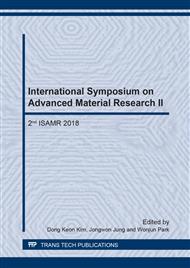p.85
p.95
p.101
p.109
p.115
p.122
p.128
p.134
p.140
Properties of Alkali-Activated Waste Glass-Cement Cementitious Materials
Abstract:
The hydration products, microstructure and development principle of intensity of cement-glass powder cementitious materials acted in alkali and activation effect of chemical activation on waste glass powder were investigated. The principle of intensity and effect of curing time was analyzed by changing alkali type, content of alkali, incorporation of glass powder, incorporation method of activators and other factor. The result shows that: sodium carbonate and sodium silicate can single stimulate activity of glass powder under a certain condition, the activated effect of combined admixture is superior to the effect on single-doped activator, under the action of an excitation agent, surface hydrolysis of glass powder takes place on the glass body first and the hydration products occurs, The pozzolanic reactivity of glass powder increases gradually and generated a larger amount of hydration products,which has lapped and interlocked growth between each other,and form the compact hardened matrix. In addiation, the shorting of curing time is used by activator, the result may be lead to initial curing and against in engineering construction.
Info:
Periodical:
Pages:
134-139
Citation:
Online since:
July 2018
Authors:
Price:
Сopyright:
© 2018 Trans Tech Publications Ltd. All Rights Reserved
Share:
Citation:


